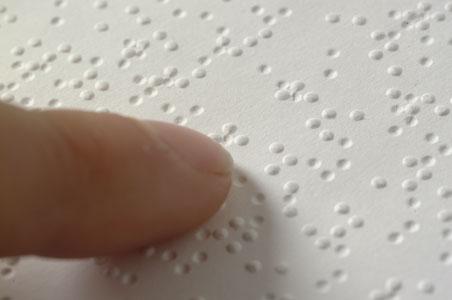“Braille is read by passing one's fingertips over characters made up of an arrangement of one to six embossed points. The relative positions of these points represent different alphanumeric characters. Braille can be written with a Braillewriter (similar to a typewriter) or by using a pointed stylus to punch dots through paper using an instrument called a Braille slate, which has rows of small cells in it as a guide.3 Braille has since been adapted to almost every known language and is an essential tool for blind people everywhere.” - Roth and Fee 2011
Braille


Close up of Interpoint Braille page
Lrcg2012, CC BY-SA 3.0 <https://creativecommons.org/licenses/by-sa/3.0>, via Wikimedia Commons
Unicode Chart 

DISCLAIMER: This script is still being researched
Data
| ISO 15924 | Brai 570 |
|---|---|
| Type | Alphabet (Nonlinear) |
| Family | Artificial |
| Direction | LtR |
| Diacritics | Yes |
| Contextual Forms | Yes |
| Capitals Used | Yes |
| Glyphs | 26 |
| Inventor | Louis Braille |
| Earliest Location | Paris, France |
| Earliest Date | 1829 CE |
| Latest Date | Present |
| Ancestry |
|
Overview
Bibliography
| Author | Year | Publication | Publisher |
|---|---|---|---|
| Jiménez, Javier, Jesús Torres, Immaculada Alonso, Dirk harder, and Konstanze Fischer | 2009 | Biography of Louis Braille and Invention of the Braille Alphabet, Survey of Ophthalmology, Volume 54, Issue 1, 2009, Pages 142-149, | Survey of Ophthamology |
| Roth, Ginny A and Fee, Elizabeth | 2011 | The Invention of Braille, Vol 101, Iss 3, (Mar 2011): 454 | American Journal of Public Health |